Priority Pollutants Monitoring and Water Quality Assessment in the Siret River Basin, Romania
Abstract
1. Introduction
- The monitoring of the priority organic and inorganic pollutants from the Siret River basin, Romania, in the view of the implementation of the WFD requirements, and
- The evaluation of the water quality of the Siret River basin, based on measured concentration of the organic and inorganic priority pollutants using the WQI method, with the purpose to establish the water quality status that will contribute to the Second river basin management plan evaluation.
2. Materials and Methods
2.1. Study Area and Monitoring Strategy
2.2. Analysis Methods
2.3. Water Quality Index Method Description
- Selecting the water quality parameters (physical, chemical, biological);
- Combining the parameters into sub-indices;
- Assigning the parameter weights values;
- Aggregating the weighted elements into a final index/results.
3. Results and Discussion
3.1. Monitoring of Priority Inorganic and Organic Pollutants
3.1.1. Priority Inorganic Pollutants
3.1.2. Priority Organic Pollutants
3.2. Water Quality Assessment
4. Conclusions
- -
- Investigation of the influence on water quality of tributaries’ pollution sources, including not only the common indicators but also priority pollutants’ surveys. These experiments should cover more sampling points and longer periods of time (at least 5 years).
- -
- Correlation with measurements considering the sediments and biota quality, so as to understand the impacts on ecosystems and risks for human health.
Author Contributions
Funding
Institutional Review Board Statement
Informed Consent Statement
Data Availability Statement
Conflicts of Interest
Abbreviations
References
- Gavrilescu, D.; Teodosiu, C.; David, M. Environmental assessment of wastewater discharges at river basin level by means of waste absorption footprint. Sustain. Prod. Consum. 2020, 21, 33–46. [Google Scholar] [CrossRef]
- Giri, S.; Mahato, M.K.; Bhattacharjee, S.; Singh, A.K. Development of a new noncarcinogenic heavy metal pollution index for quality ranking of vegetable, rice, and milk. Ecol. Indic. 2020, 113, 106214. [Google Scholar] [CrossRef]
- European Parliament; Council of the European Union. Directive 2000/60/EC of the European Parliament and of the Council Establishing a Framework for the Community Action in the Field of Water Policy. Available online: https://eur-lex.europa.eu/legal-content/en/ALL/?uri=CELEX%3A32000L0060 (accessed on 15 October 2021).
- Teodosiu, C.; Gilca, F.A.; Barjoveanu, G.; Fiore, S. Emerging pollutants removal through advanced drinking water treatment: A review on processes and environmental performances assessment. J. Clean. Prod. 2018, 197, 1210–1221. [Google Scholar] [CrossRef]
- Vega-Rodríguez, M.A.; Pérez, C.J.; Reder, K.; Flörke, M. A stage-based approach to allocating water quality monitoring stations based on the WorldQual model: The Jubba River as a case study. Sci. Total Environ. 2021, 762, 144162. [Google Scholar] [CrossRef]
- Tornero, V.; Hanke, G. Chemical contaminants entering the marine environment from sea-based sources: A review with a focus on European seas. Mar. Poll. Bull. 2016, 112, 17–38. [Google Scholar] [CrossRef]
- Nicola, G.G.; Parra, I.; Sáez, M.; Almodóvar, A.; Jiménez, B. Evaluation of PCBs and DDTs in endemic iberian barbel barbus bocagei (steindachner, 1864) populations. Sci. Total Environ. 2014, 479–480, 221–226. [Google Scholar] [CrossRef]
- Silva Barni, M.F.; Gonzalez, M.; Miglioranza, K.S.B. Assessment of persistent organic pollutants accumulation and lipid peroxidation in two reproductive stages of wild silverside (Odontesthes bonariensis). Ecotoxicol. Environ. Saf. 2014, 99, 45–53. [Google Scholar] [CrossRef] [PubMed]
- Solliec, M.; Roy-Lachapelle, A.; Storck, V.; Callender, K.; Greer, C.W.; Barbeau, B. A data-independent acquisition approach based on HRMS to explore the biodegradation process of organic micropollutants involved in a biological ion-exchange drinking water filter. Chemosphere 2021, 277, 130216. [Google Scholar] [CrossRef]
- Robu, B.; Jitar, O.; Teodosiu, C.; Strungaru, S.A.; Nicoara, M.; Plavan, G. Environmental impact and risk assessment of the main pollution sources from the Romanian black sea coast. Environ. Eng. Manag. J. 2015, 14, 331–340. [Google Scholar] [CrossRef]
- Neamtu, R.; Sluser, B.; Plavan, O.; Teodosiu, C. Environmental monitoring and impact assessment of Prut River cross-border pollution. Environ. Monit. Assess. 2021, 193, 340. [Google Scholar] [CrossRef]
- Nazeer, S.; Hashmi, M.Z.; Malik, R.N. Heavy metals distribution, risk assessment and water quality characterization by water quality index of the River Soan, Pakistan. Ecol. Indic. 2014, 43, 262–270. [Google Scholar] [CrossRef]
- Cho, E.; Khim, J.; Chung, S.; Seo, D.; Son, Y. Occurrence of micropollutants in four major rivers in Korea. Sci. Total Environ. 2014, 491–492, 138–147. [Google Scholar] [CrossRef] [PubMed]
- Kachroud, M.; Trolard, F.; Kefi, M.; Jebari, S.; Bourrié, G. Water quality indices: Challenges and application limits in the literature. Water 2019, 11, 361. [Google Scholar] [CrossRef]
- Jitar, O.; Teodosiu, C.; Oros, A.; Plavan, G.; Nicoara, M. Bioaccumulation of heavy metals in marine organisms from the Romanian sector of the Black Sea. New Biotechnol. 2015, 32, 369–378. [Google Scholar] [CrossRef] [PubMed]
- Dimri, D.; Daverey, A.; Kumar, A.; Sharma, A. Monitoring water quality of River Ganga using multivariate techniques and WQI (Water Quality Index) in Western Himalayan region of Uttarakhand, India. Environ. Nanotechnol. Monit. Manag. 2021, 15, 100375. [Google Scholar] [CrossRef]
- Mokarram, M.; Saber, A.; Sheykhi, V. Effects of heavy metal contamination on river water quality due to release of industrial effluents. J. Clean. Prod. 2020, 277, 123380. [Google Scholar] [CrossRef]
- Grecu, S.P.; Mihailescu, G.B.; Sluser, B.M. Statistical approach of environmental quality management and political decision-making at local level: Case study Iasi City, Romania. Environ. Eng. Manag. J. 2020, 19, 517–530. [Google Scholar] [CrossRef]
- Robu, B.; Macoveanu, M. Strategic environmental assessment for plans, programs, policies in Romania: Multi-criterial method. Environ. Eng. Manag. J. 2009, 8, 1451–1456. [Google Scholar] [CrossRef]
- Năstuneac, V.; Gavrilaș, S.; Munteanu, F.D. Assesment of the water quality in siret hydrographic basin. Sci. Study Res. Chem. Chem. Eng. Biotechnol. Food Ind. 2019, 20, 471–480. [Google Scholar]
- Uddin, M.G.; Nash, S.; Olbert, A.I. A review of water quality index models and their use for assessing surface water quality. Ecol. Indic. 2021, 122, 107218. [Google Scholar] [CrossRef]
- Faur, F.; Apostu, I.-M.; Lazăr, M. Study Regarding the Water Quality of Jiu River in Dolj County. Stand. Res. J. Agric. Sci. 2017, 49, 118–128. [Google Scholar]
- Badea, D.N.; Balacescu, A. Study for Evaluating the Water Quality of the Jiu River in Gorj County; Annals of the “Constantin Brancusi” University of Targu Jiu; Engineering Series; Brancusi Academic Publishing House: Târgu-Jiu, Romania, 2020. [Google Scholar]
- Duca, G.; Mereuta, A.; Velisco, N.; Tanaselia, C.; Mitina, T. Determination of quality indicators of Prut River water. Chem. J. Mold. 2019, 14, 61–67. [Google Scholar] [CrossRef]
- Lozba-Ştirbuleac, R.S.; Giurma-Handley, C.R.; Giurma, I. Water quality characterization of the Prut river. Environ. Eng. Manag. J. 2011, 10, 411–419. [Google Scholar] [CrossRef]
- Briciu, A.E.; Graur, A.; Oprea, D.I. Water quality index of suceava river in Suceava city metropolitan area. Water 2020, 12, 2111. [Google Scholar] [CrossRef]
- Iticescu, C.; Georgescu, L.P.; Murariu, G.; Topa, C.; Timofti, M.; Pintilie, V.; Arseni, M. Lower danube water quality quantified through WQI and multivariate analysis. Water 2019, 11, 1305. [Google Scholar] [CrossRef]
- Howladar, M.F.; Chakma, E.; Jahan Koley, N.; Islam, S.; Numanbakth, M.A.; Ahmed, Z.; Chowdhury, T.R.; Akter, S. The water quality and pollution sources assessment of Surma river, Bangladesh using, hydrochemical, multivariate statistical and water quality index methods. Groundw. Sustain. Dev. 2021, 12, 100523. [Google Scholar] [CrossRef]
- Pandit, D.N.; Kumari, R.; Shitanshu, S.K. A comparative assessment of the status of Surajkund and Rani Pond, Aurangabad, Bihar, India using overall Index of Pollution and Water Quality Index. Acta Ecol. Sin. 2020. [Google Scholar] [CrossRef]
- Tyagi, S.; Sharma, B.; Singh, P.; Dobhal, R. Water Quality Assessment in Terms of Water Quality Index. Am. J. Water Resour. 2020, 1, 34–38. [Google Scholar] [CrossRef]
- Ighalo, J.O.; Adeniyi, A.G. A comprehensive review of water quality monitoring and assessment in Nigeria. Chemosphere 2020, 260, 127569. [Google Scholar] [CrossRef]
- Giri, S. Water quality prospective in Twenty First Century: Status of water quality in major river basins, contemporary strategies and impediments: A review. Environ. Pollut. 2021, 271, 116332. [Google Scholar] [CrossRef]
- Akhtar, N.; Ishak, M.I.S.; Ahmad, M.I.; Umar, K.; Md Yusuff, M.S.; Anees, M.T.; Qadir, A.; Almanasir, Y.K.A. Modification of the water quality index (Wqi) process for simple calculation using the multi-criteria decision-making (mcdm) method: A review. Water 2021, 13, 905. [Google Scholar] [CrossRef]
- Călmuc, V.A.; Călmuc, M.; Ţopa, M.C.; Timofti, M.; Iticescu, C.; Georgescu, L.P. Various methods for calculating the water quality index. Ann. Dunarea De Jos Univ. Galati. Fascicle II Math. Phys. Theor. Mech. 2018, 41, 171–178. [Google Scholar] [CrossRef]
- National Management Plan for the International Hydrographic Basin of the Danube River which Is Included in the Territory of Romania 2016. Available online: http://www.mmediu.ro/articol/planul-national-de-management-aferent-portiunii-din-bazinul-hidrografic-international-al-fluviului-dunarea-care-este-cuprinsa-in-teritoriul-romanie/1530 (accessed on 14 January 2021).
- Romanian Government; National Strategy for the Sustainable Development of Romania. Horizons 2013–2020–2030. Available online: http://www.mmediu.ro/beta/domenii/dezvoltare-durabila/strategia-nationala-a-romaniei-2013-2020-2030/ (accessed on 8 March 2021).
- Protected areas of Romania. Available online: http://ananp.gov.ro/ariile-naturale-protejate-ale-romaniei/ (accessed on 15 March 2021).
- Vanmaercke, M.; Obreja, F.; Poesen, J. Seismic controls on contemporary sediment export in the Siret river catchment, Romania. Geomorphology 2014, 216, 247–262. [Google Scholar] [CrossRef]
- Draft Management Plan of the Hydrographic Space Siret. 2008. Available online: https://rowater.ro/wp-content/uploads/2020/12/Proiectul-Planului-de-Management-al-SH-Siret-octombrie-2009.pdf (accessed on 20 August 2021).
- SR ISO 5667-4; 1987-Water Quality-Sampling, Part 4: Guidance on Sampling from Lakes, Natural and Man-Made. ISO: Geneva, Switzerland, 1987.
- SR EN ISO 5667-6; 2014-Water Quality-Sampling, Part 6: Guidance On Sampling of Rivers and Streams. ISO: Geneva, Switzerland, 2014.
- SR EN ISO 5667-3; 2018-Water Quality-Sampling, Part 3: Preservation and Handling of Water Samples. ISO: Geneva, Switzerland, 2018.
- SR EN ISO 9001; 2015-Quality Management Systems—Requirements. ISO: Geneva, Switzerland, 2015.
- Romanian Ministry of Research and Inovation. Order No.161 of February 16, 2006 Approving the Norms Concerning the Classification of Surface Water Quality in order to Establish the Ecological Status of Water Bodies; Official Monitor: Bucharest, Romania, 2006. [Google Scholar]
- Government Decision No. 570 of August 10, 2016 on the Approval of the Program for the Phase-Out of Discharges, Emissions and Losses of Priority Hazardous Substances and other Measures for Major Pollutants; Romanian Government: Bucharest, Romania, 2016.
- SR EN ISO 17294-2; 2003-Water Quality-Application of Inductively Coupled Plasma Mass Spectrometry (ICP-MS), Part 2: Determination of 62 Elements. ISO: Geneva, Switzerland, 2003.
- SR EN ISO 15586; 2003-Water Quality-Determination of trace Metals Using Atomic Absorption Spectrometry with Graphite Furnace. ISO: Geneva, Switzerland, 2003.
- SR EN ISO 17852; 2006-Water Quality-Determination of Mercury, Method Using Atomic Fluorescence Spectrometry. ISO: Geneva, Switzerland, 2006.
- SR EN ISO 17993; 2002-Water Quality-Determination of 15 Polycyclic Aromatic Hydrocarbons (PAH) in Water by HPLC with Fluorescence Detection after Liquid-Liquid Extraction. ISO: Geneva, Switzerland, 2002.
- SR EN ISO 6468; 1996-Water Quality-Determination of Certain Organochlorine Insecticides, Polychlorinated Biphenyls and Chlorobenzenes, Gas Chromatographic Method after Liquid-Liquid Extraction. ISO: Geneva, Switzerland, 1996.
- SR EN ISO 10301; 1997-Water Quality-Determination of Highly Volatile Halogenated Hydrocarbons—Gas-Chromatographic Methods. ISO: Geneva, Switzerland, 1997.
- Hasan, M.A.; Nahiduzzaman, K.M.; Aldosary, A.S. Public participation in EIA: A comparative study of the projects run by government and non-governmental organizations. Environ. Impact Assess. Rev. 2018, 72, 12–24. [Google Scholar] [CrossRef]
- Chowdhury, R.M.; Muntasir, S.Y.; Hossain, M.M. Water Quality Index of water bodies along Faridpur-Barisal road in Bangladesh. Glob. Eng. Technol. Rev. 2007, 2, 2–9. [Google Scholar]
- Satish Chandra, D.; Asadi, S.S.; Raju, M.V.S. Estimation of water quality index by weighted arithmetic water quality index method: A model study. Int. J. Civ. Eng. Technol. 2017, 8, 1215–1222. [Google Scholar]
- Boyacioglu, H. Development of a water quality index based on a European classification scheme. Water SA 2007, 33, 101–106. [Google Scholar] [CrossRef]
- Iticescu, C.; Georgescu, L.P.; Topa, C.M. Assessing the Danube Water Quality Index in the City of Galati, Romania. Carpathian J. Earth Environ. Sci. 2013, 8, 155–164. [Google Scholar]
- Chauhan, A.; Singh, S. Evaluation of Ganga Water For Drinking Purpose By Water Quality. Rep. Opin. 2010, 2, 53–61. [Google Scholar] [CrossRef]
- Kothari, V.; Vij, S.; Sharma, S.K.; Gupta, N. Correlation of various water quality parameters and water quality index of districts of Uttarakhand. Environ. Sustain. Indic. 2021, 9, 100093. [Google Scholar] [CrossRef]
- Yadav, A.K.; Khan, P.; Sharma, S.K. Water quality index assessment of groundwater in todaraisingh tehsil of Rajasthan State, India-A greener approach. E-J. Chem. 2010, 7, S428–S432. [Google Scholar] [CrossRef]
- Ramakrishnaiah, C.R.; Sadashivaiah, C.; Ranganna, G. Assessment of water quality index for the groundwater in Tumkur taluk, Karnataka state, India. E-J. Chem. 2009, 6, 523–530. [Google Scholar] [CrossRef]
- Park, S.E.; Her, Y.; Kim, S.S.; Kim, C.W. Efficacy and safety of a lindane 1% treatment regimen for scabies, confirmed by dermoscopy-guided skin scraping with microscopic examination. Clin. Exp. Dermatol. 2015, 40, 611–616. [Google Scholar] [CrossRef] [PubMed]
- Lopes, C.; Persat, H.; Babut, M. Transfer of PCBs from bottom sediment to freshwater river fish: A food-web modelling approach in the RhOne River (France) in support of sediment management. Ecotoxicol. Environ. Saf. 2012, 81, 17–26. [Google Scholar] [CrossRef]
- Verhaert, V.; Covaci, A.; Bouillon, S.; Abrantes, K.; Musibono, D.; Bervoets, L.; Verheyen, E.; Blust, R. Baseline levels and trophic transfer of persistent organic pollutants in sediments and biota from the Congo River Basin (DR Congo). Environ. Int. 2013, 59, 290–302. [Google Scholar] [CrossRef]
- Blanchet-Letrouvé, I.; Zalouk-Vergnoux, A.; Vénisseau, A.; Couderc, M.; Le Bizec, B.; Elie, P.; Herrenknecht, C.; Mouneyrac, C.; Poirier, L. Dioxin-like, non-dioxin like PCB and PCDD/F contamination in European eel (Anguilla anguilla) from the Loire estuarine continuum: Spatial and biological variabilities. Sci. Total Environ. 2014, 472, 562–571. [Google Scholar] [CrossRef] [PubMed]
- Romanescu, G.; Iosub, M.; Sandu, I.; Minea, I.; Enea, A.; Dascalita, D.; Hapciuc, O.E. Spatio-temporal analysis of the water quality of the Ozana River. Rev. Chim. 2016, 67, 42–47. [Google Scholar]
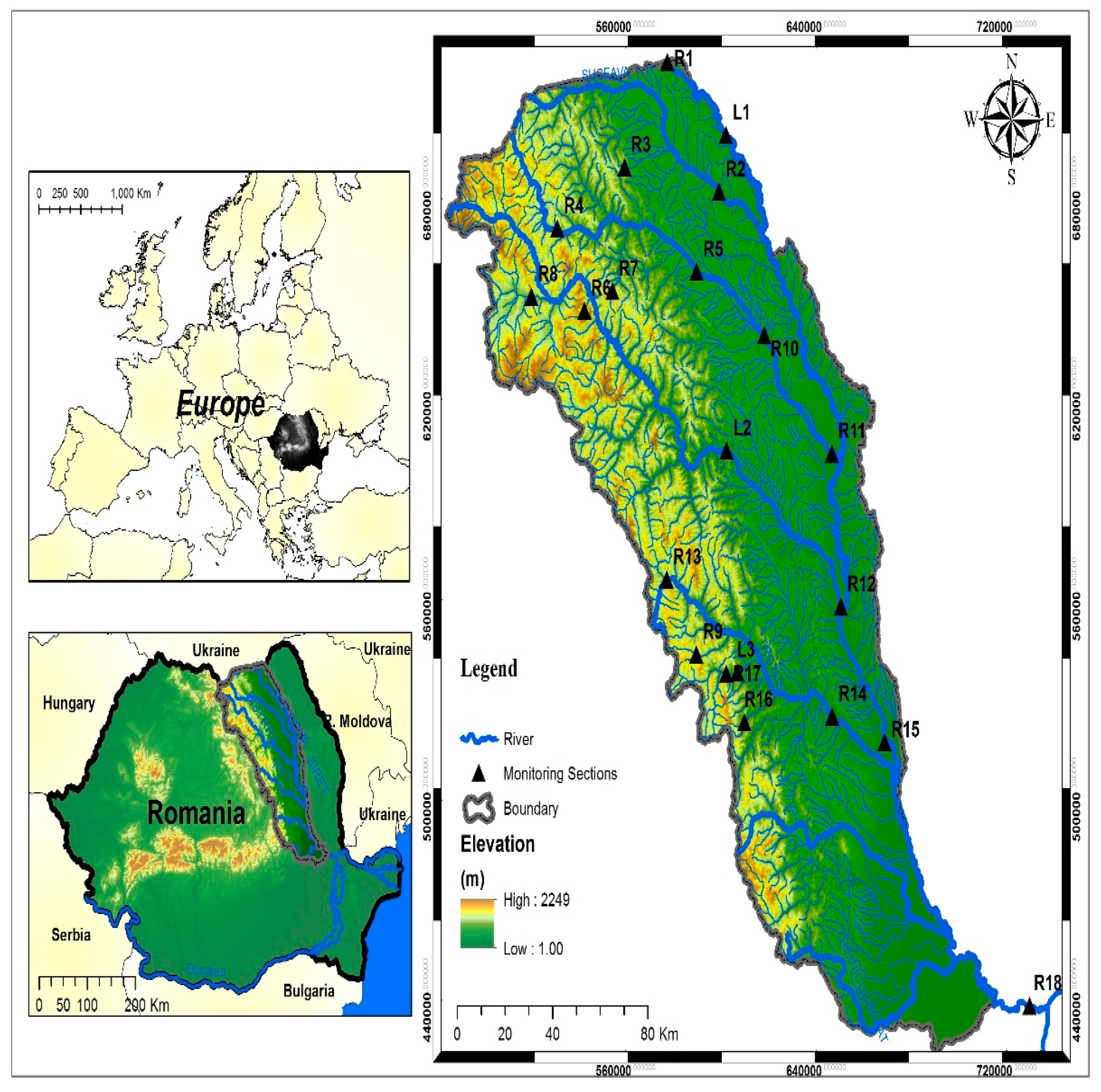
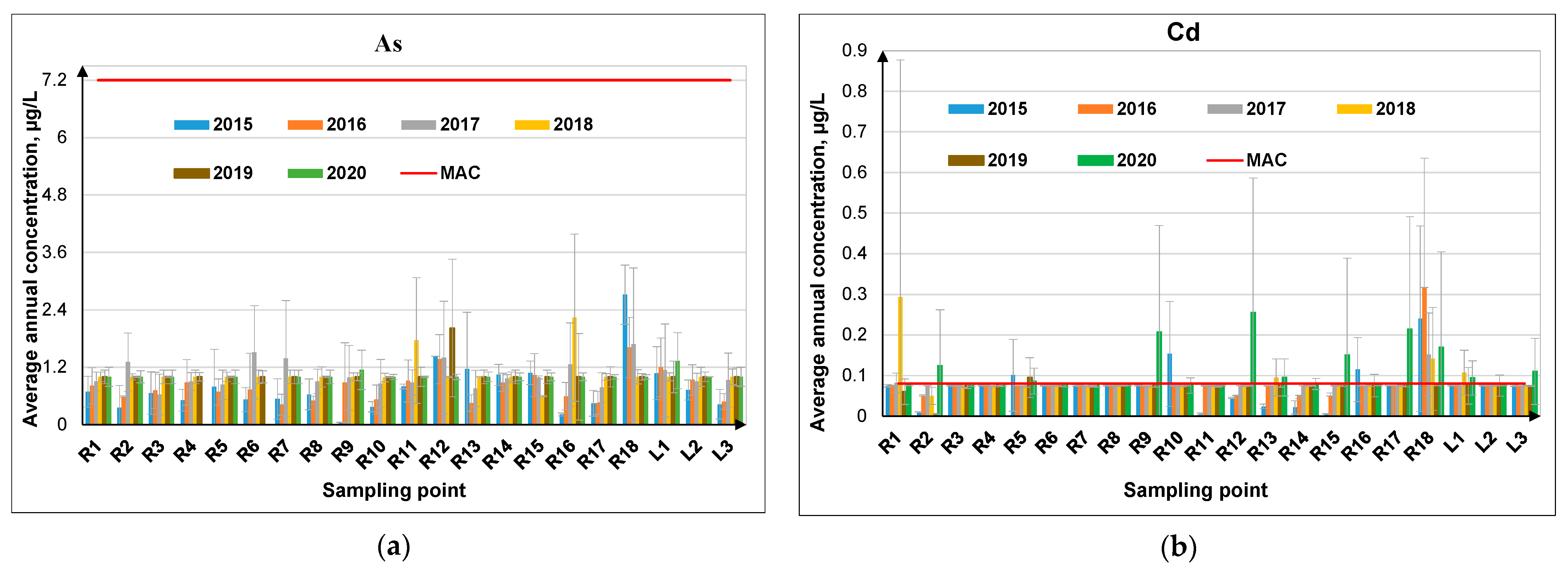
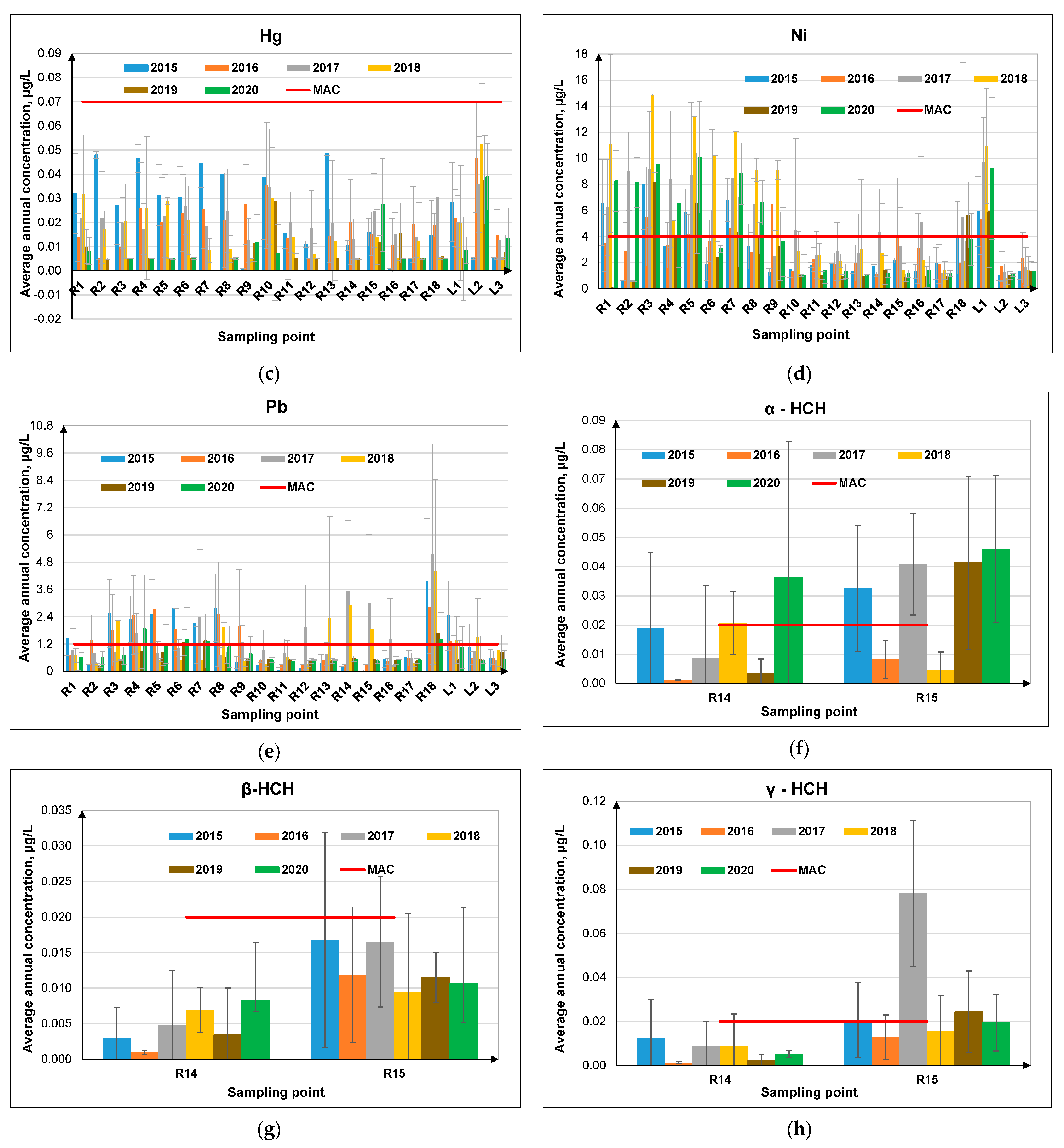

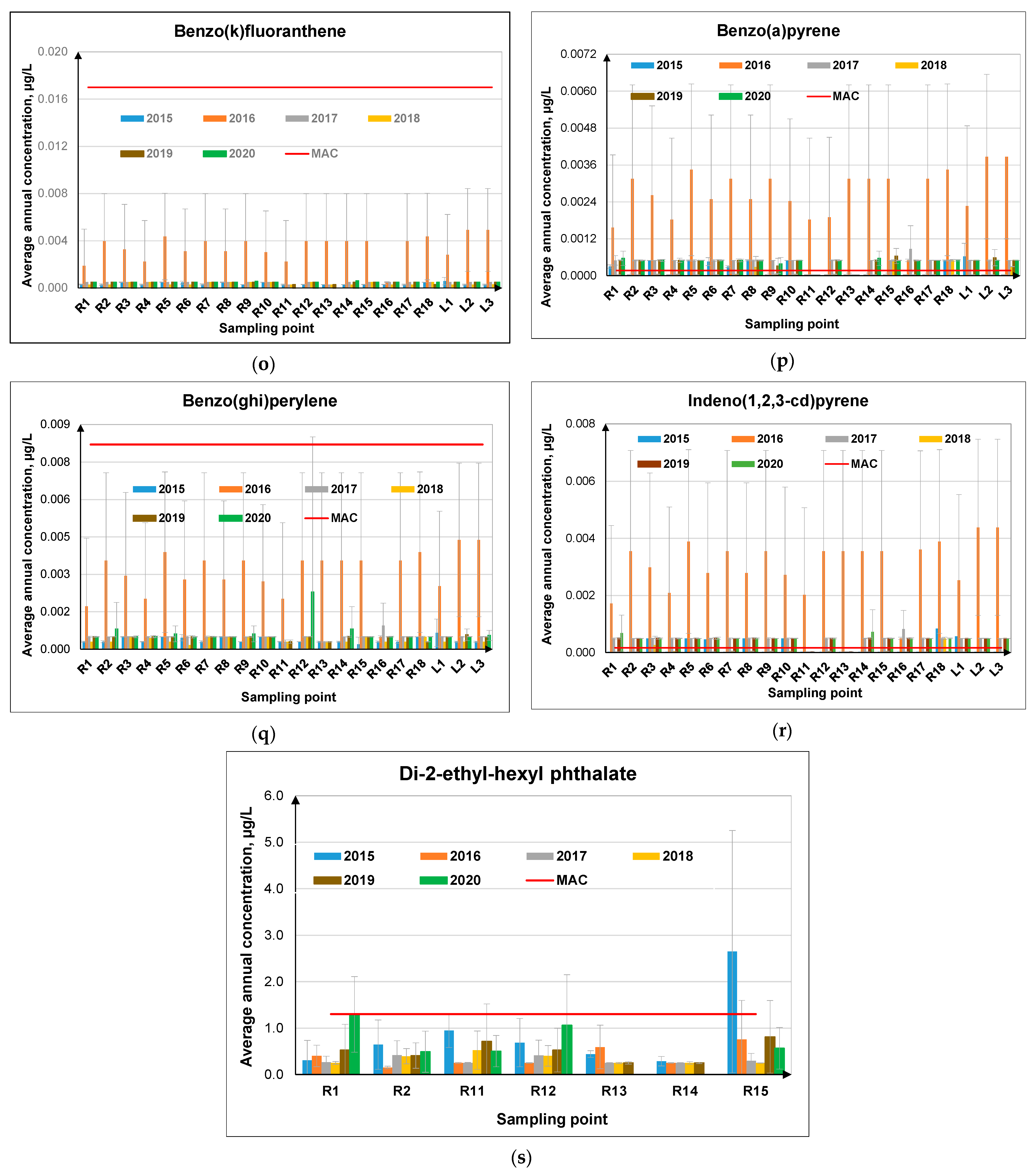
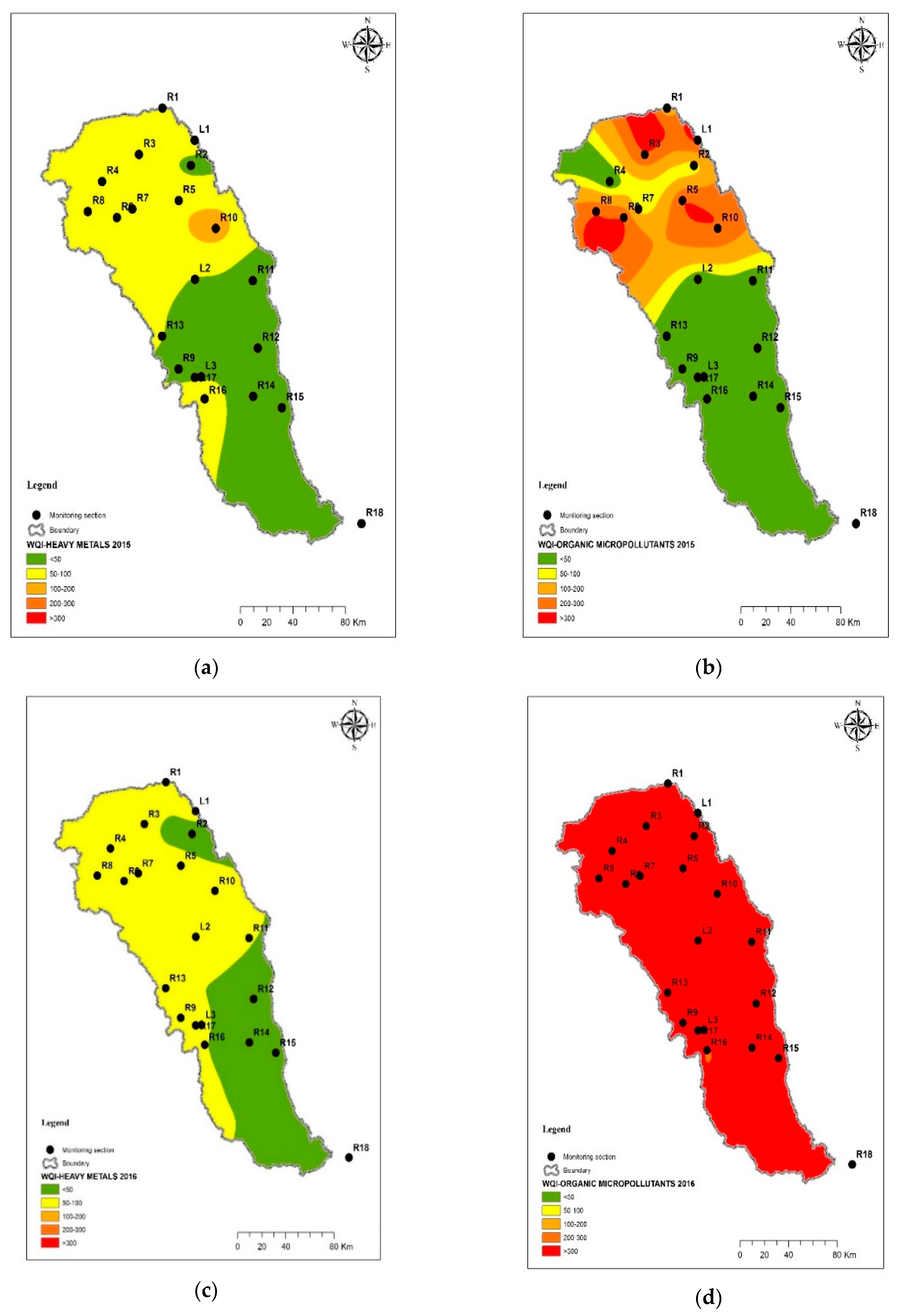

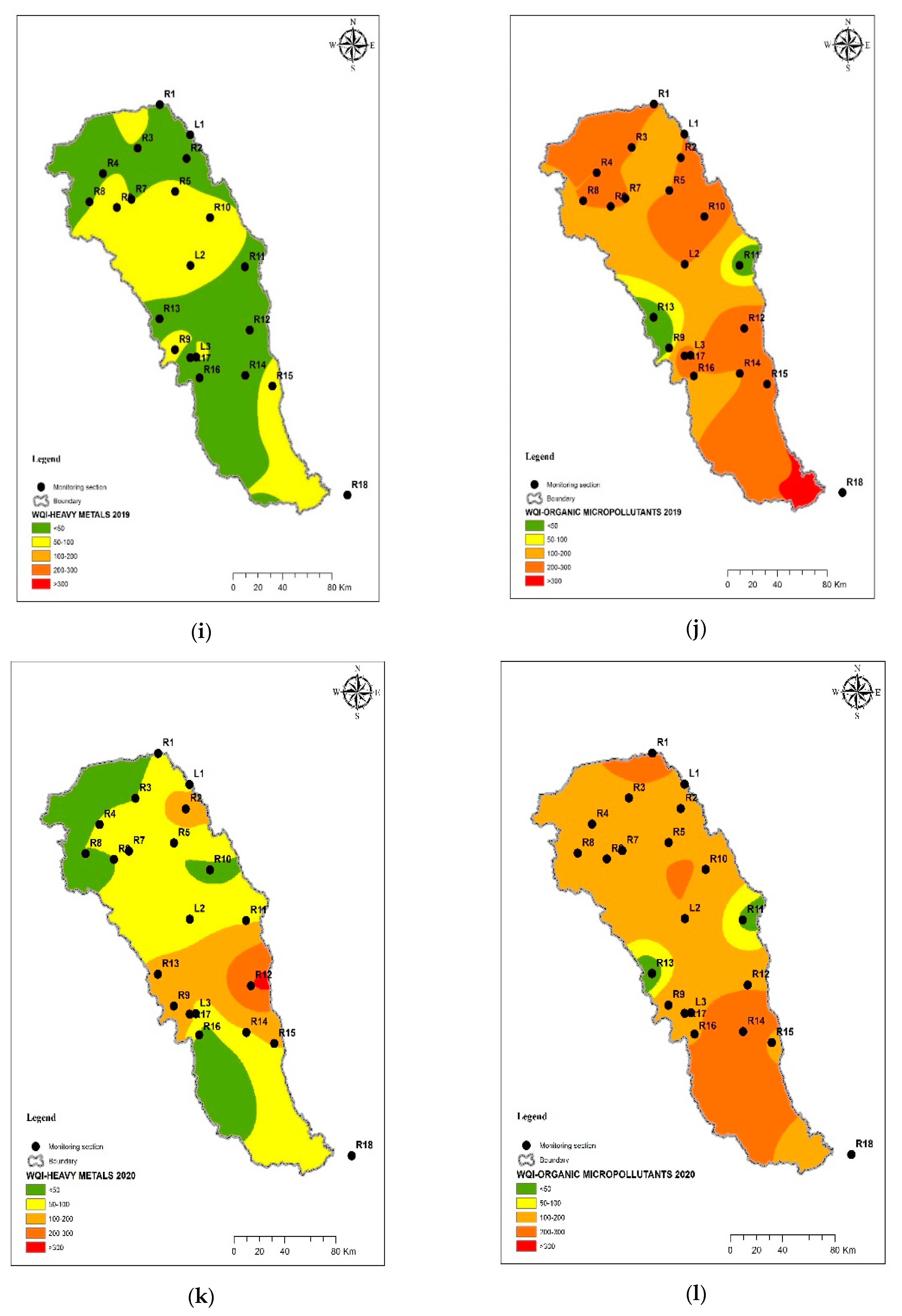
| River | Latitude | Longitude | Section Location | No. of Samples/Years | Measured Priority Pollutants/ Water Quality Indicators | |||||
|---|---|---|---|---|---|---|---|---|---|---|
| 2015 | 2016 | 2017 | 2018 | 2019 | 2020 | |||||
| R1—Siret—Siret | 47°58′58.08″ N | 26°2′11.85″ E | Ukrainian cross border | 12 | 12 | 12 | 12 | 12 | 12 | As, Cd, Hg, Ni, Pb, PAH, DEHP |
| R2—Suceava-Tisauti | 47°37′45.96″ N | 26°19′8.13″ E | Downstream of Suceava city | 2 | 4 | 12 | 8 | 12 | 12 | As, Cd, Hg, Ni, Pb, PAH, DEHP |
| R3—Solca—Solca | 47°42′3.67″ N | 25°47′28.62″ E | Water abstraction point | 12 | 4 | 4 | 4 | 4 | 4 | As, Cd, Hg, Ni, Pb, PAH |
| R4—Moldova—Fundul Moldovei | 47°32′15.57″ N | 25°24′52.15″ E | Reference station | 4 | 4 | 4 | 4 | 4 | 4 | As, Cd, Hg, Ni, Pb, PAH |
| R5—Moldova—Baia | 47°24′55.22″ N | 26°11′20.88″ E | Water abstraction points | 12 | 12 | 8 | 4 | 8 | 8 | As, Cd, Hg, Ni, Pb, PAH |
| R6—Barnarel—Crucea | 47°18′57.95″ N | 25°33′46.18″ E | 12 | 12 | 4 | 4 | 4 | 4 | As, Cd, Hg, Ni, Pb, PAH | |
| R7—Baisescu—Ostra | 47°22′4.3″ N | 25°43′8.83″ E | 4 | 4 | 4 | 4 | 4 | 4 | As, Cd, Hg, Ni, Pb, PAH | |
| R8—Dorna—Dorna Candreni | 47°21′16.58″ N | 25°16′6.74″ E | 12 | 12 | 8 | 4 | 8 | 8 | As, Cd, Hg, Ni, Pb, PAH | |
| R9—Ciobanus—Ciobanus | 46°23′6.86″ N | 26°9′54.7″ E | 4 | 4 | 8 | 4 | 8 | 8 | As, Cd, Hg, Ni, Pb, PAH | |
| R10—Moldova—Timisesti | 47°14′27.05″ N | 26°33′35.6″ E | 12 | 12 | 12 | 8 | 8 | 12 | As, Cd, Hg, Ni, Pb, PAH | |
| R11—Moldova—Roman | 46°54′54.93″ N | 26°55′24.26″ E | Downstream of Roman city | 2 | 4 | 12 | 8 | 8 | 8 | As, Cd, Hg, Ni, Pb, PAH, DEHP |
| R12—Bistrita—Downstream Bacau | 46°30′8.84″ N | 26°57′28.93″ E | Downstream of the treatment plant—Bacau city | 2 | 4 | 12 | 4 | 8 | 12 | As, Cd, Hg, Ni, Pb, PAH, DEHP |
| R13—Trotus Downstream Lunca | 46°35′15.46″ N | 26°0′20.7″ E | Trotus river spring | 2 | 4 | 12 | 4 | 8 | 12 | As, Cd, Hg, Ni, Pb, PAH, DEHP |
| R14—Trotus—Vranceni | 46°12′30.48″ N | 26°54′2.6″ E | Downstream of Onesti industrial platform | 2 | 4 | 12 | 8 | 12 | 12 | As, Cd, Hg, Ni, Pb, PAH, α-HCH, β-HCH, γ-HCH, DEHP |
| R15—Trotus—Adjud | 46°7′59.99″ N | 27°11′0″ E | Upstream of confluence with the Siret river | 2 | 4 | 12 | 8 | 8 | 12 | As, Cd, Hg, Ni, Pb, PAH, α-HCH, β-HCH, γ-HCH, DEHP |
| R16—Slanic—Slanic Moldova | 46°11′56.81″ N | 26°25′15.6″ E | Upstream Slanic Moldova | 4 | 4 | 4 | 4 | 8 | 4 | As, Cd, Hg, Ni, Pb, PAH |
| R17—Uz—Poiana Uzului | 46°19′54.5″ N | 26°19′36.73″ E | Upstream of Uz Lake | 12 | 12 | 12 | 12 | 12 | 12 | As, Cd, Hg, Ni, Pb, PAH |
| L1—Bucecea lake | 45°44′33.81″ N | 27°21′5.97″ E | Water abstraction point | 12 | 12 | 12 | 12 | 12 | 12 | As, Cd, Hg, Ni, Pb, PAH |
| L2—Batca Doamnei lake | 47°46′58.58″ N | 26°21′38.46″ E | 12 | 12 | 12 | 12 | 12 | 12 | As, Cd, Hg, Ni, Pb, PAH | |
| L3—Poiana Uzului lake | 46°55′55.81″ N | 26°20′34.2″ E | 12 | 12 | 12 | 12 | 12 | 12 | As, Cd, Hg, Ni, Pb, PAH | |
| R18—Siret—Sendreni | 46°20′5.55″ N | 26°23′18.39″ E | Upstream of the confluence with the Danube river | 12 | 12 | 12 | 12 | 12 | 12 | As, Cd, Hg, Ni, Pb, PAH |
| Water Quality Parameters | Analysis Methods | Maximum Allowed Concentration (MAC) According to GD 570/2016 [45] | Unit |
|---|---|---|---|
| As | Method of Inductively coupled plasma mass spectrometry (ICP-MS) according to ISO 17294-2:2003 [46] and Method using atomic absorption spectrometry with graphite furnace according to ISO 15586:2003 [47] | 7.2 | μg/L |
| Cd | 0.08 | μg/L | |
| Ni | 4 | μg/L | |
| Pb | 1.2 | μg/L | |
| Hg | Method using atomic fluorescence spectrometry according to ISO 17852:2006 [48] | 0.007 | μg/L |
| Naphthalene | Method using High Performance Liquid Chromatography (HPLC) with fluorescence detection after liquid—liquid extraction according to ISO 17993:2002 [49] | 2 | μg/L |
| Anthracene | 0.1 | μg/L | |
| Phenanthrene | 0.03 | μg/L | |
| Fluoranthene | 0.0063 | μg/L | |
| Benzo(b)fluoranthene | 0.017 | μg/L | |
| Benzo(k)fluoranthene | 0.017 | μg/L | |
| Benzo(ghi)perylene | 0.0082 | μg/L | |
| Benzo(a)pyrene | 0.00017 | μg/L | |
| Benzo(a)anthracene | 0.00017 | μg/L | |
| Indeno(1,2,3-cd)pyrene | 0.00017 | μg/L | |
| α-HCH, β-HCH and γ-HCH | Gas chromatographic method after liquid-liquid extraction according to ISO 6468: 1996 [50] | 0.02 | μg/L |
| DEHP | Gas chromatographic method for determination of phthalates according to ISO10301:1997 [51] | 1.3 | μg/L |
| Water Quality Status References | WQI | Class | |
|---|---|---|---|
| [30,54,59] | [14,58,60] | ||
| Excellent | 0–25 | <50 | A |
| Good | 26–50 | 50–100 | B |
| Poor | 51–75 | 100–200 | C |
| Very poor | 76–100 | 200–300 | D |
| Unsuitable for drinking | >100 | >300 | E |
| Section/ WQI Values | Years | ||||||||
|---|---|---|---|---|---|---|---|---|---|
| 2015 | 2016 | 2017 | 2018 | 2019 | 2020 | ||||
| R1 | 120.91 | 925.01 | 287.13 | 17.59 | 200.73 | 244.65 | |||
| R2 | 69.47 | 1882.29 | 287.10 | 17.36 | 200.68 | 196.12 | |||
| R3 | 286.93 | 1775.15 | 286.91 | 28.88 | 200.75 | 196.90 | |||
| R4 | 17.39 | 1096.43 | 287.08 | 286.72 | 200.75 | 196.90 | |||
| R5 | 287.25 | 2059.15 | 286.84 | 17.40 | 200.78 | 196.92 | |||
| R6 | 287.00 | 1489.56 | 286.77 | 17.39 | 200.78 | 196.90 | |||
| R7 | 68.93 | 1882.45 | 286.90 | 28.86 | 200.75 | 197.05 | |||
| R8 | 287.04 | 1483.29 | 287.33 | 28.87 | 200.75 | 196.90 | |||
| R9 | 17.34 | 1882.26 | 287.28 | 28.85 | 28.86 | 175.55 | |||
| R10 | 287.13 | 1447.03 | 287.07 | 28.88 | 286.72 | 196.90 | |||
| R11 | 17.42 | 1084.46 | 17.39 | 17.38 | 17.37 | 85.64 | |||
| R12 | 17.63 | 1643.62 | 287.09 | 28.85 | 286.68 | 197.35 | |||
| R13 | 17.49 | 1882.18 | 17.39 | 17.40 | 17.37 | 111.62 | |||
| R14 | 17.90 | 1866.95 | 284.98 | 17.73 | 199.21 | 251.59 | |||
| R15 | 18.42 | 1879.14 | 285.84 | 29.04 | 285.39 | 196.45 | |||
| R16 | 17.37 | 286.73 | 454.65 | 17.37 | 196.92 | 196.90 | |||
| R17 | 17.37 | 1894.17 | 286.95 | 17.35 | 286.69 | 197.02 | |||
| R18 | 351.88 | 2059.76 | 296.60 | 287.73 | 17.38 | 197.09 | |||
| L1 | 325.34 | 1350.22 | 287.06 | 17.42 | 200.75 | 196.92 | |||
| L2 | 17.37 | 2317.14 | 287.15 | 17.43 | 200.76 | 196.93 | |||
| L3 | 17.37 | 1446.94 | 286.96 | 17.37 | 200.75 | 196.95 | |||
| Excellent | Good | Poor | |||||||
| Very poor | Unsuitable for drinking | ||||||||
Publisher’s Note: MDPI stays neutral with regard to jurisdictional claims in published maps and institutional affiliations. |
© 2022 by the authors. Licensee MDPI, Basel, Switzerland. This article is an open access article distributed under the terms and conditions of the Creative Commons Attribution (CC BY) license (https://creativecommons.org/licenses/by/4.0/).
Share and Cite
Zait, R.; Sluser, B.; Fighir, D.; Plavan, O.; Teodosiu, C. Priority Pollutants Monitoring and Water Quality Assessment in the Siret River Basin, Romania. Water 2022, 14, 129. https://doi.org/10.3390/w14010129
Zait R, Sluser B, Fighir D, Plavan O, Teodosiu C. Priority Pollutants Monitoring and Water Quality Assessment in the Siret River Basin, Romania. Water. 2022; 14(1):129. https://doi.org/10.3390/w14010129
Chicago/Turabian StyleZait, Roxana, Brindusa Sluser, Daniela Fighir, Oana Plavan, and Carmen Teodosiu. 2022. "Priority Pollutants Monitoring and Water Quality Assessment in the Siret River Basin, Romania" Water 14, no. 1: 129. https://doi.org/10.3390/w14010129
APA StyleZait, R., Sluser, B., Fighir, D., Plavan, O., & Teodosiu, C. (2022). Priority Pollutants Monitoring and Water Quality Assessment in the Siret River Basin, Romania. Water, 14(1), 129. https://doi.org/10.3390/w14010129









